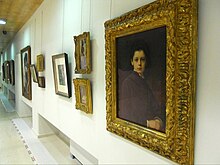
Back تثمين الفن Arabic Valoración del arte Spanish Artearen balorazio Basque Procjena umjetnosti Croatian Taxatie Dutch Sanat değerlemesi Turkish








Art valuation, an art-specific subset of financial valuation, is the process of estimating the market value of works of art. As such, it is more of a financial rather than an aesthetic concern, however, subjective views of cultural value play a part as well. Art valuation involves comparing data from multiple sources such as art auction houses, private and corporate collectors, curators, art dealer activities, gallerists (gallery owners), experienced consultants, and specialized market analysts to arrive at a value.[1][2][3] Art valuation is accomplished not only for collection, investment, divestment, and financing purposes, but as part of estate valuations, for charitable contributions, for tax planning, insurance, and loan collateral purposes. This article deals with the valuation of works of fine art, especially contemporary art, at the top end of the international market, but similar principles apply to the valuation of less expensive art and antiques.
- ^ Coslor, Erica (April 2016). "Transparency in an opaque market: Evaluative frictions between "thick" valuation and "thin" price data in the art market". Accounting, Organizations and Society. 50: 13–26. doi:10.1016/j.aos.2016.03.001. hdl:11343/113919.
- ^ Velthuis, Olav (19 August 2007). Talking Prices. Princeton University Press. ISBN 9780691134031. Retrieved 9 June 2017.
- ^ Ertug, Gokhan; Yogev, Tamar; Lee, Yonghoon G.; Hedström, Peter (1 February 2016). "The Art of Representation: How Audience-specific Reputations Affect Success in the Contemporary Art Field". Academy of Management Journal. 59 (1): 113–134. doi:10.5465/amj.2013.0621. ISSN 0001-4273.